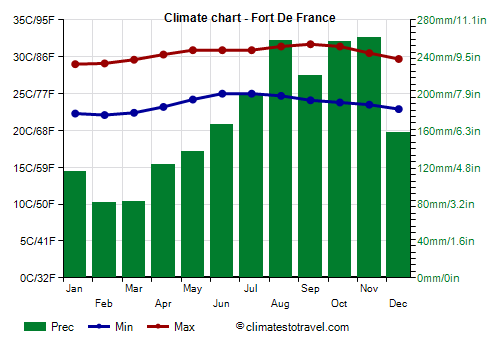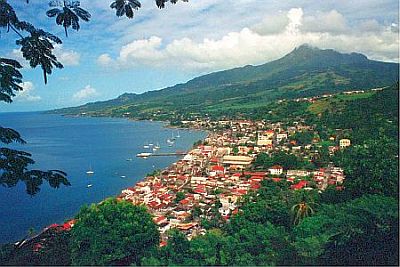Select units of measurement for the temperature and rainfall tables (metric or imperial).
Average weather, temperature, rainfall, sunshine
In Martinique, the climate is
tropical, hot and humid all year round. There is a relatively cool, dry season from January to mid-April, called
carême (Lent), and a hot, humid and rainy season from mid-June to mid-November, called
hivernage (the root of the word reminds of the winter, although it is a hot season, and also quite sunny).
Relative humidity is high throughout the year and remains above 70% even in the afternoon.
Martinique is an island of the Caribbean, which has the status of a French overseas department.
The climate in detail
Seasons and rains
In the cool and dry period, the
northeast trade winds, constant winds typical of tropical climates, blow steadily and with moderate intensity, while in the hottest period, these winds are more irregular, and may have some breaks, increasing the feeling of sultriness.
Between them, there are two
transitional periods: from mid November to early January (when the northeast winds start to blow, the temperature decreases a bit, and the weather gets better) and from mid-April to Mid-June (when both the temperature and the frequency of downpours gradually increase).
Rainfall in Martinique varies greatly in quantity depending on area, but it follows the same pattern, and it's more frequent and abundant from May to November (with a peak from July to November) and less frequent and of shorter duration from December to April (and especially in February and March, which are the driest months).
The northern part of the island, occupied by
hills and mountains, is rainier than the south. In particular, on the slopes of
Mount Pelée, 1,397 meters (4,583 feet) high (see Le Morne Rouge), and of the
Carbet Mountains, which reach a height of 1,197 meters (3,927 feet), the rains are very abundant, in fact, they exceed 4,000 mm (160 in) per year; moreover, the sky is often cloudy, and there is no real dry season, so much so that the climate can be called equatorial, as is also evidenced by the lush vegetation.
In the southern part of the island, precipitation drops below 2,000 mm (79 in) per year, and along the east and south coasts (see Le Vauclin, Sainte-Anne), it goes down to around 1,200/1,500 mm (47/60 in) per year.
The rains in Martinique occur throughout the year especially as
downpours or thunderstorms, which could be intense, but generally do not last long, so they do not reduce too much the sunshine hours; sometimes, however, there may be a more intense wave of bad weather.
Fort-de-France

In
Fort-de-France, the capital, the average temperature ranges from around 25 °C (77 °F) between January and February, to around 28 °C (82.5 °F) from June to September. As you can see, there are no great variations between between the coolest and the warmest period.
In Fort-de-France, which is located in the central part of the island, 2,050 millimeters (81 inches) of rain fall per year, of which more than 100 mm (4 in) fall per month from April to December, and among these, more than 200 mm (8 in) from August to November, which is the rainiest period. The least rainy months are February and March, with around 80 mm (3.1 in) per month.
Along the coasts, the amount of
sunshine is good all year round, though not exceptional, as there are around 2,500 hours of sunshine per year.

Sea temperature
The
sea in Martinique is pleasantly warm all year round, in fact the water temperature fluctuates between 26.5 °C (79.5 °F) in February and March, to 29 °C (84 °F) in September and October.
Hurricanes
Martinique can be hit by tropical storms and cyclones, called
hurricanes in the Caribbean, which can affect this area from June to November, though they are most likely from August to October.
When to go
The best time to visit Martinique is from
February to April, since it is the least rainy period of the year.
December and January are a bit more rainy, but less so than in the July-November period: considering that they are in the least hot period, and that there may be some showers in all seasons, after all, you can also choose December and January.
What to pack
All year round: bring
light clothes of natural fabric, a sun hat, sunscreen, and possibly a light sweatshirt and a light raincoat for thunderstorms. From December to March, you can add a light sweatshirt for the evening.
When going to the reef, you can bring snorkeling equipment, including water shoes or rubber-soled shoes.
When going hiking to the mountains, bring a sweatshirt, a raincoat and hiking boots.
Climate data - Martinique
| Fort De France |
|---|
|
| Jan | Feb | Mar | Apr | May | Jun | Jul | Aug | Sep | Oct | Nov | Dec |
|---|
| Min temp. | 22 | 22 | 22 | 23 | 24 | 25 | 25 | 25 | 24 | 24 | 24 | 23 |
|---|
| Max temp. | 29 | 29 | 30 | 30 | 31 | 31 | 31 | 31 | 32 | 31 | 30 | 30 |
|---|
| Precip. | 115 | 80 | 80 | 125 | 140 | 165 | 200 | 255 | 220 | 255 | 260 | 160 |
|---|
| Prec. days | 19 | 14 | 13 | 12 | 13 | 16 | 20 | 20 | 18 | 18 | 19 | 18 |
|---|
| Humidity | 78% | 76% | 75% | 76% | 77% | 78% | 79% | 80% | 81% | 82% | 82% | 79% |
|---|
| Day length | 11 | 12 | 12 | 12 | 13 | 13 | 13 | 13 | 12 | 12 | 11 | 11 |
|---|
| Sun hours | 7 | 7 | 7 | 7 | 7 | 6 | 6 | 7 | 7 | 6 | 6 | 7 |
|---|
| Sea temp | 27 | 27 | 27 | 27 | 28 | 28 | 28 | 29 | 29 | 29 | 28 | 28 |
|---|
| La Trinité |
|---|
|
| Jan | Feb | Mar | Apr | May | Jun | Jul | Aug | Sep | Oct | Nov | Dec |
|---|
| Min temp. | 22 | 22 | 23 | 23 | 24 | 24 | 24 | 25 | 25 | 24 | 24 | 23 |
|---|
| Max temp. | 28 | 28 | 28 | 29 | 29 | 29 | 30 | 30 | 31 | 30 | 29 | 28 |
|---|
| Precip. | 125 | 100 | 100 | 205 | 205 | 175 | 200 | 210 | 205 | 320 | 295 | 155 |
|---|
| Prec. days | 19 | 15 | 14 | 14 | 16 | 17 | 22 | 20 | 18 | 21 | 20 | 18 |
|---|
|
|
|
| Sea temp | 27 | 27 | 27 | 27 | 28 | 28 | 28 | 29 | 29 | 29 | 28 | 28 |
|---|
| Le Morne Rouge (450 meters) |
|---|
|
| Jan | Feb | Mar | Apr | May | Jun | Jul | Aug | Sep | Oct | Nov | Dec |
|---|
| Min temp. | 20 | 20 | 20 | 21 | 22 | 23 | 23 | 23 | 22 | 22 | 21 | 21 |
|---|
| Max temp. | 26 | 26 | 26 | 27 | 28 | 27 | 28 | 28 | 29 | 28 | 27 | 26 |
|---|
| Precip. | 380 | 255 | 265 | 310 | 335 | 355 | 465 | 465 | 435 | 450 | 530 | 440 |
|---|
| Prec. days | 26 | 22 | 22 | 20 | 21 | 24 | 27 | 27 | 23 | 24 | 26 | 25 |
|---|
|
|
|
|
| Le Vauclin |
|---|
|
| Jan | Feb | Mar | Apr | May | Jun | Jul | Aug | Sep | Oct | Nov | Dec |
|---|
| Min temp. | 24 | 24 | 24 | 25 | 26 | 26 | 26 | 26 | 26 | 26 | 25 | 25 |
|---|
| Max temp. | 28 | 28 | 28 | 29 | 30 | 30 | 30 | 30 | 31 | 30 | 29 | 28 |
|---|
| Precip. | 55 | 45 | 45 | 85 | 85 | 100 | 115 | 135 | 145 | 160 | 180 | 80 |
|---|
| Prec. days | 12 | 9 | 9 | 9 | 11 | 13 | 17 | 16 | 14 | 16 | 16 | 13 |
|---|
|
|
|
| Sea temp | 27 | 27 | 27 | 27 | 28 | 28 | 28 | 29 | 29 | 29 | 28 | 28 |
|---|